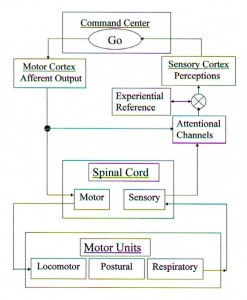A sudden flash of insight has challenged my notion of Perceived Effort. For weeks, I had been trying to get ‘my head around’ the role of the motor cortex in the effort required for maintaining running pace, versus no role for a cortex required for the decorticate cat who can still trot once startled into flight. 1, 2

Locomotor signal processing Model (2008)
And recently, while I was out running, I started tracking, well, paying attention to, my “Go” signal (see Figure to left from http://www.endurance-education.com/what-limits-endurance/limiting-mechanisms/). Was it there or not?
What I noticed was surprising! While jogging on the level at a slow pace for me, I was doing more thoughts about “Where is the next patch of thick grass for my sore feet?” than “Push on each stride”; “What is my Rating of Perceived Exertion” was not anywhere in my self-talk. Coming to an upslope, however, to maintain my pace, at first I did have to focus a bit on “Push a little more with each stride”, then once I noticed that I was pushing “hard enough” my self-talk shifted to focus upon running relaxed, and I comfortably crest the little hill. At the end of my workout, against my better judgment, I decided to do an ‘end spurt’ as the English, etc., like to speak of a finish kick; so at a chosen spot, at a bridge across a small river, I thought “PUSH, PUSH” for a few strides to pick up the pace, and then my self-talk switched to “Keep this up” as my legs were pushing the pace fast enough. My take-home interpretation was that the motor cortex etc. was not all that involved in maintaining gait and was involved in changing pace. Also my working phrase for Effort or Exertion was “Push.”
All of this was sparked first very recently by reading the paper by Klaus Jahn’s group, “Real versus imagined locomotion” 3 where they posit an “executive” versus a “planning” neural network. Second, shortly after that, I read the paper by Ahn & Hogan on “Walking is not like reaching” 4 in which they suggest that locomotor control “is hierarchically organized with a semi-autonomous peripheral oscillator operating under episodic supervisory control”. Wow! Amazing! An executive/supervisor is periodically checking on “How am I doing?” Very interesting….
Now, how to set up the methods and experimental design to explore Effort or Exertion as part of a supervised or supervising neural network? This seems to be daunting, challenging question.
Anyone out there been doing studies on this question? Please post a comment!
References:
1 Raethjen J, Muthuraman M (2012) Corticomuscular coupling in human locomotion: muscle drive or gait control? J Physiol 590: 3631-2.
2 Grillner S, Wallén P, Saitoh K, Kozlov A, Robertson B (2008) Neural bases of goal-directed locomotion in vertebrates—An overview. Brain Research Reviews 57: 2-12.
3 la Fougère C, Zwergal A, Rominger A, Förster F, Fesl G, Dieterich M, Brandt T, Strupp M, Bartenstein P, Jahn K (2010) Real versus imagined locomotion: A [18F]-FDG PET-fMRI comparison, NeuroImage 50: 1589-1598.
4 Ahn J, Hogan N (2012) Walking Is Not Like Reaching: Evidence from Periodic Mechanical Perturbations. PLoS ONE 7(3): e31767. doi:10.1371/journal.pone.0031767.